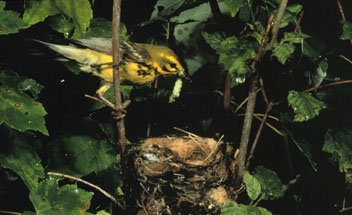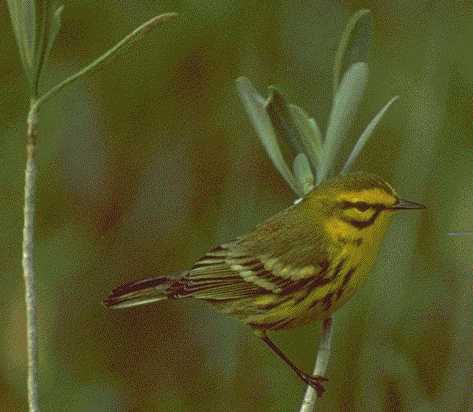Plants and Animals
Setophaga discolor Prairie warbler
Key Characteristics
The Prairie warbler is a medium sized warbler that has yellowish-green upperparts and a bright yellow under-surface. Prominent black streaks are confined to the flanks and chestnut colored streaks are apparent (upon close examination) along the back. Two black streaks are on the head (one through the eye, and the other along the jaw). Sexual dimorphism is minor with females having less prominent streaking. Immatures look similar to females. The song of the Prairie warbler is a distinctive buzzy song that ascends in scale (e.g., zee, zee, zee, zee zeet!). Typical songs consist of 8-14 notes. There are only a few yellowish warblers, including the Prairie warbler, that bob their tail while perching.
Status and Rank
US Status: No Status/Not Listed
State Status: SC - Special Concern (rare or uncertain; not legally protected)
Global Rank: G5 - Secure
State Rank: S3 - Vulnerable
Occurrences
| County | Number of Occurrences | Year Last Observed |
|---|---|---|
| Alcona | 1 | 1998 |
| Allegan | 5 | 2003 |
| Benzie | 2 | 1997 |
| Berrien | 2 | 2014 |
| Cass | 1 | 1997 |
| Cheboygan | 1 | 1986 |
| Delta | 1 | 2000 |
| Iosco | 3 | 2016 |
| Leelanau | 2 | 1993 |
| Mason | 1 | 2007 |
| Muskegon | 1 | 1998 |
| Newaygo | 1 | 2007 |
| Oakland | 1 | 2003 |
| Oceana | 1 | 2014 |
| Oscoda | 4 | 1997 |
| Presque Isle | 1 | 1998 |
| Schoolcraft | 1 | 1995 |
| St. Joseph | 1 | 1997 |
| Van Buren | 1 | 1997 |
| Washtenaw | 1 | 2005 |
Information is summarized from MNFI's database of rare species and community occurrences. Data may not reflect true distribution since much of the state has not been thoroughly surveyed.
Habitat
Prairie warblers use a variety of early successional shrubby/scrubby habitats including young pine plantations and clearcuts in oak forests. They may be found in small patches but nesting success is greater in larger patches.
Natural Community Types
For each species, lists of natural communities were derived from review of the nearly 6,500 element occurrences in the MNFI database, in addition to herbarium label data for some taxa. In most cases, at least one specimen record exists for each listed natural community. For certain taxa, especially poorly collected or extirpated species of prairie and savanna habitats, natural community lists were derived from inferences from collection sites and habitat preferences in immediately adjacent states (particularly Indiana and Illinois). Natural communities are not listed for those species documented only from altered or ruderal habitats in Michigan, especially for taxa that occur in a variety of habitats outside of the state.
Natural communities are not listed in order of frequency of occurrence, but are rather derived from the full set of natural communities, organized by Ecological Group. In many cases, the general habitat descriptions should provide greater clarity and direction to the surveyor. In future versions of the Rare Species Explorer, we hope to incorporate natural community fidelity ranks for each taxon.
Management Recommendations
Management practices that are beneficial to the Prairie warbler include prescribed burning, allowing natural succession to proceed in fields, creating large cut-over areas, maintenance of large thickets in agricultural areas, and establishment of pine plantations. Dune/shoreline habitats should be protected since they often provide excellent habitat for Prairie warblers and are one of the few areas where they are found with some regularity. Before creating early seral habitats for the Prairie warbler in a largely forested area, managers should assess the impacts on other species, such as forest interior birds. Extensive tracts of forest should not be fragmented with numerous open areas, since many species are sensitive to patch size and cowbird parasitism increases as habitats become more fragmented. Rather, large contiguous blocks of open habitats and forest should be aggregated into separate areas to abate the adverse effects of fragmentation on open-land and forest interior species. Prairie warbler management is most likely compatible with Kirtland's warbler management, pine barrens restoration, and regeneration of upland shade intolerant tree species such as oak, pines, and aspen.
Active Period
Migration from fourth week of April to second week of May
Migration from third week of August to fourth week of September
Nesting from third week of May to fourth week of July
Survey Methods
A standard survey methodology for this species is to systematically place observation points every ¼ mile throughout suitable habitat. At each observation point an observer listens for 10 minutes and records all birds observed and/or heard within 50 m and beyond 50 m of the survey point. Another simple method is to simply walk a transect through suitable habitat during the breeding season (mid-May to mid-July) and record individuals observed and/or heard. All surveys should be conducted between sunrise and 10:30 am during good to fair weather conditions (e.g., low winds, dry).
Listen at observation points
Survey Period: From third week of May to third week of July
Time of Day: Morning (sunrise)
References
Survey References
- Bibby, C.J., N.D. Burgess, and D.A. Hill. 1992. Bird Census Techniques. Academic Press, New York.
Technical References
- Cooper, J.L. 2000. Special Animal Abstract for Dendroica discolor (Prairie warbler). Michigan Natural Features Inventory, Lansing, MI 3pp.
- Evers, D.C. 1994. Endangered and Threatened Wildlife of Michigan. The University of Michigan Press, Ann Arbor. 412pp.





